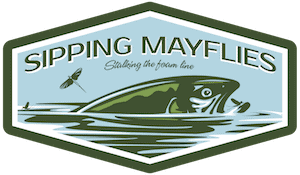The Best Ice Fishing Flies
Feb. 14th, 2022
The best ice fishing flies are patterns that sink quickly and resemble wintertime prey such as nymphs, scuds, midges, and minnows, which are active year-round, even under ice.
You’ll generally be targeting panfish such as sunfish, bluegills, perch, and crappies, but can also catch walleye and northern pike on occasion.
I’ll explain to you the best fly patterns to use, as well as the most productive techniques and tactics.
Do Flies Work for Ice Fishing?
Yes, flies can work very well during ice fishing excursions, especially tungsten beadhead fly patterns. You’ll definitely want to pay special attention to the depth of the water and the topography of the bottom of the lake or river.
I highly recommend tying-on two flies, around 3-feet apart, so long as it’s allowed by your state regulations (Fish & Wildlife or DNR). This way, you can test two fly patterns to see which one the fish may be keying-in on.
Here’s a trout I caught on a fly while fishing on ice in January.
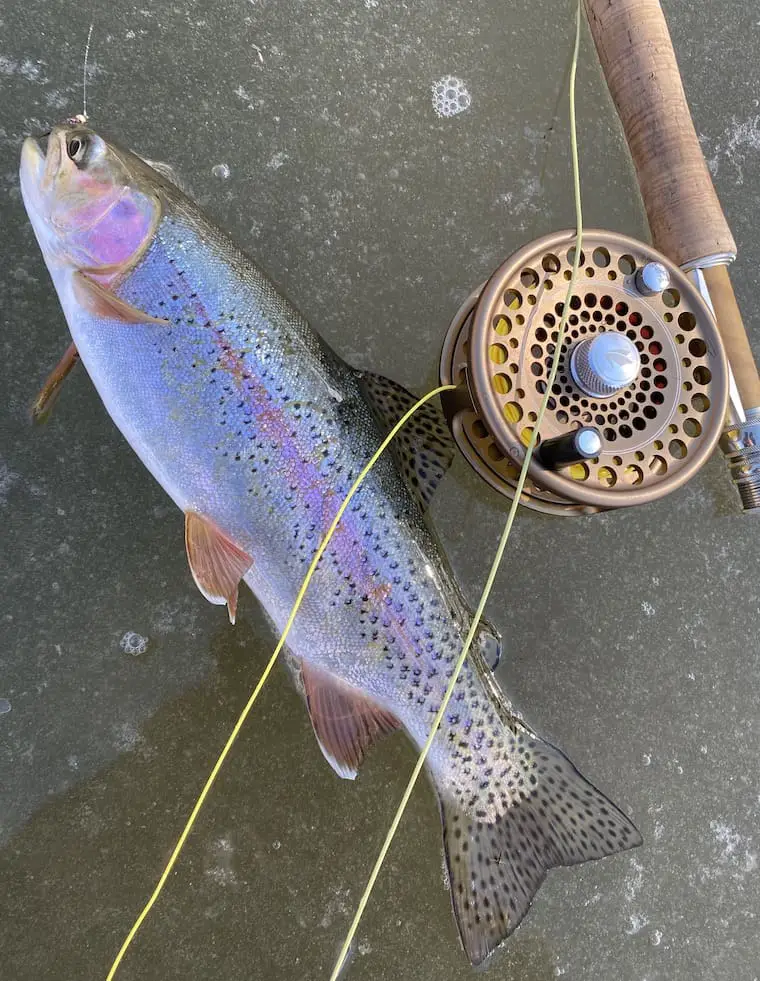
Your main focus should be getting the flies down near the bottom, and even bouncing off the bottom of the lake or river, if possible. The reason is because the prey items your imitating live in the muck on the bottom, and in the weeds.
The prey will include, as mentioned earlier, midges, scuds, minnows, and nymphs. The most productive ice fishing imitations mimic scuds and nymphs, in my experience.
Once your beadhead flies are near the bottom (or on the bottom), you’ll want to start jigging them. It’s very important to make sure you’re jigging them slowly.
During the winter, fish slow down. They don’t want to chase prey, they want easy meals. The metabolism of the fish has slowed, and they don’t need to eat as much.
So, jig your flies slowly, moving your rod up and down 6-12 inches at a time. When you feel any resistance at all, set the hook before the fish spits-out your fly.
Your jigging will, of course, be vertical (up-and-down) in nature due to the limited size of the hole in the ice.
When a fish takes your fly, it generally won’t be a savage take. Keep constant tension on your line so you can feel any bites.
Don’t forget to check out my article on winter fly fishing tips.
The Best Flies for Ice Fishing
The fly patterns that will work best when ice fishing will generally be smaller in size, and will always have beadheads. Tungsten beadheads are better than brass and other metals because tungsten is much heavier and will sink faster. In fact, tungsten is heavier than lead.
Ice Fishing Fly Patterns
Bead head wet flies – Fish are attracted to the soft hackle of wet flies. The soft hackle undulates in the water as you jig, and gives the fly pattern life. Specifically, I’ve caught a lot of fish on a size 16 beadhead soft hackle Pheasant tail wet flies. Green is a good color.
Perch and walleye tend to prefer these slightly larger fly patterns, but you’ll need to get your flies near the bottom.
Prince nymphs – These nymph patterns work particularly well under ice, when compared to other common nymphs like the hare’s ear and copper john. Nymphs are active year-round. Jig these flies using the technique I described above. I’d recommend using the beadhead version in size 18-22.
Panfish (sunnies, bluegills, crappies) will eat your nymph gently, so stay focused.
Scuds – Scuds are bottom-dwelling crustaceans and fish eat them with fervor. Bounce your scud pattern off the bottom and you’ll have a fish on your line in no time. I recommend these flies in sizes 18-20. My favorite colors are olive and green.
I’ve found that crappies, bluegills, bream, and other panfish have an affinity for scuds.
Midges – Midges are synonymous with cold water, ice, and winter. They hatch year-round. I’ve had great success using the larval form as a fly pattern, specifically the zebra midge or red midge. You should use the beadhead versions in sizes 18-20.
Panfish will key-in on your midges. Here’s a picture I took of an adult midge on the ice in January.
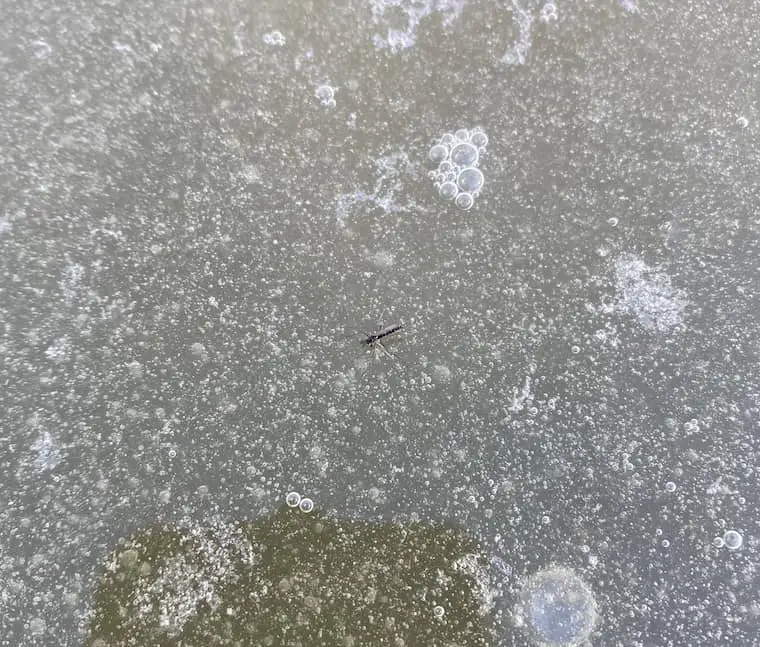
How to Tie Ice Fishing Flies
There aren’t any tricks or special techniques you need to use to tie flies for ice fishing. They’re just regular flies, the same ones you’d use year-round.
Avoid using CDC feathers and foam in your flies because of their buoyant properties. You want your flies to sink quickly and to be responsive while you’re jigging.
Also, just a reminder to use tungsten beadheads instead of brass.
Ice Fishing Fly Rods
You’re definitely not going to use a traditional fly rod when you’re ice fishing, unless you want to be sitting nine-feet from the hole in the ice. Aside from looking ridiculous, a long rod wouldn’t give you the leverage you need to set the hook briskly. Landing a fish would also pose a major challenge, since you’d need to set your rod down and walk over to the hole.
You’ll want a rod that’s much more compact, something in the range of three-feet long, give or take. It wouldn’t actually be a fly rod, just a regular spinning rod.
If you’re a fly fishing purist, the shortest fly rod I’ve ever seen is 5-feet, 6-inches. This is also too long to be ideal when you’re ice fishing, but you could get away with it.
Ice Fishing Fly Reels
If you’re going to use a 5-foot 6-inch fly rod, then virtually any reliable fly reel will be just fine for ice fishing. Click-pawl or disc drag reels will work well. Sage is my personal favorite brand.
However, if you’re going to be using a more traditional ice fishing rod (compact and short), I’d recommend a reliable spinning reel, nothing fancy.
Ice Thickness Safety
According to the Farmers Almanac rules, ice needs to be 3-inches thick to support a single person and 7.5-inches for a car. It also recommends that cars are parked at least 50 feet apart and moved every two hours. Lastly, it says when you’re driving on ice, keep your seatbelt off and doors unlocked.
Bring a drill to test the thickness of the ice. Don’t take unnecessary risks.
Here’s a picture of a river I often fish, taken in January. The river is frozen over, but keep in mind that the strength of river ice is 15% less than still water ice, and slush ice has only half the strength of blue ice.
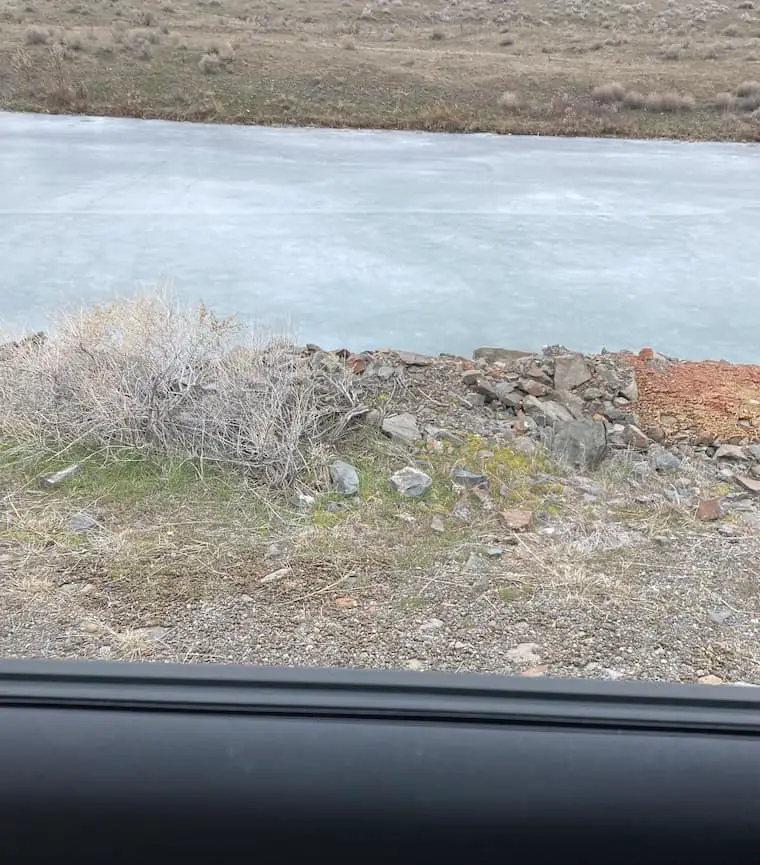
I grew up in a cold climate and once in a while our lake would freeze and the ice would be crystal clear, like glass, despite being several inches thick. I could stand on the ice and look down through it into the water, watching the fish forage, like it was my own aquarium.
Once I saw a painted turtle swimming underneath the ice directly below where I was standing. It noticed me, and then just continued on its way.
Summary
One of the joys of ice fishing is never knowing what species of fish you’re going to pull out of the hole, it could be anything from a panfish to a northern pike. Now that you know which flies work best, and the most productive techniques (jigging), you’re ready to hit the lake this winter.
In my experience, the most commonly caught species are bluegills (Lepomis macrochirus) and other sunnies, crappies (Pomoxis annularis), yellow perch (Perca flavescens), northern pike (Esox lucius), and walleye (Sander vitreus). Some folks call walleyes “yellow pickerel,” but that’s not what we call them where I’m from.
You’ll likely catch some unusual species like eelpout (Gymnelus hemifasciatus), which is a species that has always mildly fascinated me.
Once spring arrives and you’re ready to fish open waters, read my article on fly fishing muddy water and spring runoff.
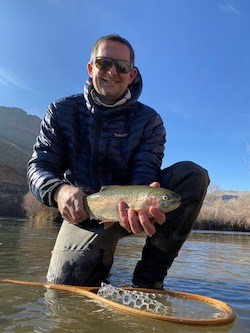
About the Author
My name's Sam and I'm a fly fishing enthusiast just like you. I get out onto the water 80+ times each year, whether it's blazing hot or snow is falling. I enjoy chasing everything from brown trout to snook, and exploring new waters is something I savor. My goal is to discover something new each time I hit the water. Along those lines, I record everything I learn in my fly fishing journal so I can share it with you.
Follow me on Instagram , YouTube, and Facebook to see pictures and videos of my catches and other fishing adventures!
